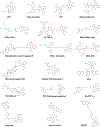Mitochondria as a Novel Target for Cancer Chemoprevention: Emergence of Mitochondrial-targeting Agents
- PMID: 33303695
- PMCID: PMC8137522
- DOI: 10.1158/1940-6207.CAPR-20-0425
Mitochondria as a Novel Target for Cancer Chemoprevention: Emergence of Mitochondrial-targeting Agents
Abstract
Cancer chemoprevention is the most effective approach to control cancer in the population. Despite significant progress, chemoprevention has not been widely adopted because agents that are safe tend to be less effective and those that are highly effective tend to be toxic. Thus, there is an urgent need to develop novel and effective chemopreventive agents, such as mitochondria-targeted agents, that can prevent cancer and prolong survival. Mitochondria, the central site for cellular energy production, have important functions in cell survival and death. Several studies have revealed a significant role for mitochondrial metabolism in promoting cancer development and progression, making mitochondria a promising new target for cancer prevention. Conjugating delocalized lipophilic cations, such as triphenylphosphonium cation (TPP+), to compounds of interest is an effective approach for mitochondrial targeting. The hyperpolarized tumor cell membrane and mitochondrial membrane potential allow for selective accumulation of TPP+ conjugates in tumor cell mitochondria versus those in normal cells. This could enhance direct killing of precancerous, dysplastic, and tumor cells while minimizing potential toxicities to normal cells.
©2020 American Association for Cancer Research.
Conflict of interest statement
Figures



References
-
- Warburg O The Metabolism of Carcinoma Cells. The Journal of Cancer Research. 1925;9(1):148.
-
- Racker E. Bioenergetics and the Problem of Tumor Growth: An understanding of the mechanism of the generation and control of biological energy may shed light on the problem of tumor growth. American Scientist. 1972;60(1):56–63. - PubMed
Publication types
MeSH terms
Substances
Grants and funding
LinkOut - more resources
Full Text Sources
Medical

